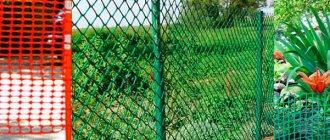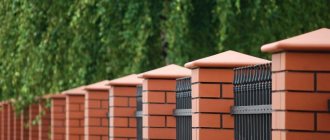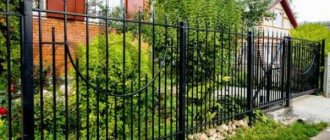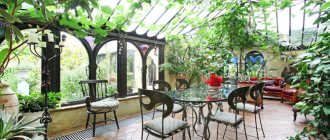Chain-link mesh is the most common item used for installing fences. This material looks quite beautiful, as well as being durable and easy to use. Chain-link is not an expensive material at all.
With all its advantages, chain-link mesh is suitable for creating barriers of any complexity. It is very simple to create an artistic masterpiece from such material. And many people do it quite well. There are a lot of photos online of chain-link fences that people assembled with their own hands.
Advantages of metal mesh
The advantages of using metal fencing include:
- Strength.
- Ease of construction work.
- Elasticity. The flexible frame allows you to stretch the fence mesh between the posts along the perimeter of a site of any shape.
- Relatively low cost of material.
The presence of a number of advantages in the mesh determines its widespread use and popularity.
Pros of mesh fences
Chain-link mesh is popular in the building materials market and has established itself as an affordable and easy-to-install material.
Fence on a summer cottage
Advantages of metal mesh fencing:
- Every person who is not involved in construction will be able to install this iron fence;
- can be purchased at a relatively low price, and in the Leroy Merlin chain of stores delivery is made free of charge to the site, taking into account the order estimate;
- air circulation throughout the entire territory;
- mesh fences are characterized by good quality and long service life, taking more than 30 years;
- the fence fits perfectly into any landscape design;
- this fence does not shade the garden area;
- if the homeowner has dogs, they can guard the area as effectively as possible so that thieves cannot steal something;
- This is a really reliable fence on which you can install barbed wire if required, this ensures inaccessibility.
Gate in the fence
The product is an excellent material intended for fastening in internal areas of a certain territory, for example, in playgrounds, places where animals are kept and other types of fences. In addition, the list of disadvantages is not as long as the advantages.
Selection of necessary materials
Before installing a chain-link fence, you need to prepare the following minimum set of tools and materials:
- Direct mesh.
- Support pillars. Most often, metal pipes of sufficient diameter are used. Today, manufacturers of building materials produce special pipes with hooks on the side surfaces so that the mesh can be attached.
- Sand, cement and crushed stone for pouring support structures.
- Wire, construction corners.
- Pliers, hammer.
To make a good fence with your own hands, a craftsman may need other tools, such as a tape measure, a shovel, or wire curlers.
Dimensions and cost
The strength of the flexible material and the reliability of the use of chain-link mesh in the design of the gate directly depend on the combination of the wire diameter and the mesh size. The larger diameter of the steel wire allows the use of chain-link with large cells.
Fence with gate
Fine-mesh mesh made of thinner metal is not inferior in reliability and quality. The most durable material is with the maximum metal content per square meter of the product: thicker wire and smaller mesh size - a more reliable fence or gate made of chain-link.
Fence mesh is sold in rolls, the parameters of which are 1.5–1.8 m in height and 10 meters in length.
Recommended cell sizes are from 20x20 to 50x50 mm.
Fence in the village
The retail price per meter of chain-link made of galvanized wire 1.6 mm with a cell size of 50x50 mm is about 1,480 rubles. The same mesh made of metal with a diameter of 2.8 mm and a PVC coating costs from 2,330 rubles. If a strong fence is required, the thickness of the metal wire is at least 3 mm.
Types of mesh
Today in stores you can find the following options for a mesh frame for installing a fence:
Mesh without anti-corrosion coating. This option is the cheapest, which makes it widely used.
Galvanized mesh for fence. It is a more expensive option, but does not require additional processing and maintenance.
Mesh with polymer coating. A fence made of polymer mesh is a more expensive model, and also has an original appearance due to the auxiliary decorative coating.
The choice of a mesh frame depends on the purpose of the fence (back fence, mesh for future vertical gardening), the financial capabilities of the owner of the site, and the interior of the yard.
Video description
About the idea for decorating a fence in the following video:
Using plants
Landscaping a chain-link fence can be done in two ways. The first, faster one suggests using climbing plants; the specific cellular structure becomes an ideal support for them. The design of the fence is picturesque and serves as an independent decoration of the site; Some plants have a subtle aroma.
If you want quick results, choose low-maintenance annuals such as sweet peas or nasturtiums. Morning glory and kobea with bell flowers look romantic.
Kobeya in the fence Source yandex.net
Perennials will not braid the fence so quickly. Wild (maiden) grapes and Chinese lemongrass form a beautiful green wall after a few years. Wild grapes are especially beautiful in the fall, when their foliage turns different shades of red.
Wild grapes Source hitsad.ru
Some perennials are characterized by accelerated growth, so to form a decorative wall they need to tie up rapidly lengthening shoots. Hops, honeysuckle and clematis fall into the category of fast-growing perennials.
Hops will decorate any fence Source botanichka.ru
Calculation of the required material
For an accurate calculation, it is necessary to take into account the following points in construction:
- The general perimeter of the area to be fenced. The quantity of chain-link mesh is always calculated with a reserve (approximately 1 roll “in reserve”).
- Distance between supporting structures.
- Soil density. After establishing this indicator, you can easily calculate the length of the underground part of the support column and the above-ground section of the pipe.
- The number of support posts will allow you to properly stock up on fastening hooks.
All calculations made must be transferred to paper in order to eliminate unnecessary expenses in the future.
Types of fence installation
Depending on the method of fastening, the following methods are distinguished:
- Tension fence.
- Tensile structure with metal guides.
- Sectional installation method.
Each technique has its own characteristics, advantages and disadvantages.
Advantages and disadvantages
Before building this fence, it is necessary to determine in detail all the advantages and disadvantages.
A homemade fence made from reinforcement has the following advantages:
- Fast installation. If, for example, you bought an abandoned dacha and want to quickly fence it off from prying eyes, then a welded fence from reinforcement can be built in a very short time.
- Low cost. These fences, if they have a simple design and are made by hand, are much cheaper than fences made of natural stone or brick.
In the village
However, a fence made of reinforcing mesh has certain disadvantages:
- Susceptibility to corrosive processes. If a brick fence is simply “built and forgotten,” then a metal fence will require regular coating with paints and varnishes.
- Inability to hide the territory from prying eyes. Although such a disadvantage may well be an advantage for someone. Some people do not like to install monolithic fences in their dachas, since garden crops do not grow well in the shade of the fence. A reinforced fence is ideal for those people who constantly plant something in their garden. At the same time, you can create a hedge near such a fence. Taking into account the growth, it will close the territory from neighbors.
Near the house
Tension fence without guides
The installation technology provides for the simplest method: support pillars and mesh frame blanks are attached in the usual tightening way.
The design is not particularly durable; over time it can sag and be subject to deformation when exposed to mechanical factors.
Tensile structure with additional guides
As additional structures, you can use wooden beams, metal pipes or fittings. The advantage of such devices is their strength.
The mesh does not sag over time and is not subject to mechanical stress. This type of fence can be used as a support for vertical gardening.
Methods for installing chain-link
Having determined where the fence will stand, it is necessary to schematically depict the future structure and draw up a cost estimate.
We recommend using metal pipes as pillars, after applying an anti-corrosion agent to them.
The building site is cleared of debris and vegetation. Marking is carried out using pegs and a stretched rope.
Further creation of the fence depends on the selected type of mesh fastener. Let's look at each of them in more detail.
Tensioner
It is easy to install and low cost. One edge of the chain-link is fixed to the post, the other is pulled tightly. The recommended distance between supports is no more than 2.5 m.
To achieve good tension of the mesh, you can use the following intermediate fasteners:
- clamps;
- cable;
- lanyard;
- hook with long thread.
The disadvantage of this method of fixation is that the chain-link will begin to sag, so it is better to use it to create small temporary fences.
Sectional
A good fence option for areas that are on a slope, on sandy, moving soils.
It is recommended to install the posts at a depth below the freezing point of the soil. The supports are fastened using any method other than concreting.
It is better to choose metal as a material for racks. For brick supports, you will have to install the mortgages in advance.
Photo: sectional fence made of metal corner and chain-link
An alternative is to buy sections in a store.
The work order is as follows:
- Steel plates 5 mm thick, 5 cm wide, 15–30 cm long are welded to the pillars. They are fastened at a distance of 20 cm from the top and bottom of the supports.
- The frame is made from a metal corner measuring 30*40, 40*50 mm. A corresponding piece of mesh fabric is welded inside the frame. Reinforcement rods are inserted along the edges and fixed with spot welding.
- An alternative solution is to weld long hooks 3 mm thick, bend them inward and attach a chain-link to them. After tensioning the mesh, it is better to weld the ends of the hooks so that the mesh does not slip off over time.
The finished frames are cleaned, coated with an anti-corrosion agent and painted in a suitable color.
With guide
A type of tension. It is mounted using the same method, but 2-3 metal ones are welded between the pillars or wooden logs are fixed.
On heaving soils, pillars should not be concreted; it is better to install them below the freezing point of the soil and backfill them.
With metal rod
This is a tension-type fence, which is strengthened by pulling strong wire through the mesh. They fasten it along the top and bottom rows of the chain-link so that the fabric does not begin to sag over time.
The simplest way is to make a loop out of wire, throw it over a post, tighten it, thread it through the cells to the next post and repeat the procedure.
You can weld plates with hooks to the supports and attach a metal rod to them. There is an option to buy special tensioners for wire, but they will not be cheap, and when installing a budget structure made from chain-link, it is not profitable.
It is convenient to use mesh fabric as a sectional material for fencing in summer cottages, when, in conditions of limited finances, it is necessary to delineate the boundaries of the estate without shading the plants growing nearby. For other purposes, it is worth using chain link to create a temporary fence.
Sectional model
The technique involves welding metal frames onto which the mesh is stretched. The support pillars are installed in the usual way, the frames with a mesh frame are attached to the construction corners. Advantages of using this model:
- A fence made of welded mesh has sufficient strength.
- It is easy to subsequently produce a broken section.
- If necessary, you can install additional gates from two adjacent sections.
The only drawback is that for such a design you will have to place the supports quite deep.
Installation of a tension fence on the site
The process of installing a mesh fence consists of a series of successive steps:
- Marking the territory.
- Preparing trenches for supports.
- Installation of supporting structures.
- Attaching the mesh frame.
For each stage you can find detailed video tutorials and instructions for carrying out construction work.
Advantages of cooperation with our company
- Leader-fence has its own production base, where it produces building materials, metal structures and sections for mesh fences, among others. This allows us to build fences cheaper, since we use materials at cost,
- Responsibility for the results of your work,
- Order execution time – maximum 3 days,
- We build fences from different materials and provide other services,
- We respect the wishes of our clients, but we are not afraid to express our professional opinion in order to save your money.
Our skill and experience are at your service.
Territory marking
Before installing the fence, it is necessary to carry out a number of preparatory work:
- At the site where support structures are installed, debris and debris are removed and the soil is leveled.
- Stakes or other signal markers are installed at the corner points of the fenced area.
- For the convenience of subsequent work, you can stretch a cord between the markers.
- Mark the locations of supporting structures, gates, and wickets.
When working, it is best to use a detailed drawing.
Installation of supporting structures
First of all, the volume and ratio of the future cement mortar is calculated. Then proceed according to the scheme:
- A metal plate should be welded to the base of each pipe, which acts as a load and support, as well as hooks (if they are not installed by the manufacturer).
- The pillars must be coated with a layer of primer and then paint. This will protect the structures from corrosion.
- Metal pipes are placed in prepared trenches and reinforced with temporary wooden posts. The installation of pipes is always carried out in pairs: then, using a level, the same height of the supports is determined.
- Next, the holes are filled using the prepared cement mortar.
Perform sequential installation of all supports on the site. Plugs are placed on the upper ends of the pipes to protect the interior from rainwater.
Installation of a sectional model
Represents a series of sequential actions:
- Preparation of support frames using a welding machine.
- Cutting the mesh to the dimensions specified in the preliminary drawing.
- Attaching the mesh frame to the inner surface of the support frame.
You can make a country fence not only from mesh, because the variety of materials on the construction market is simply vast.
However, using a chain-link will allow you to save on financial investments, and the mesh frame can be further decorated if desired.
Other types of welded structures
Fences can be made not only from reinforcement; there are also other welded structures.
Let's briefly consider the most popular fencing options that you can make yourself.
Chain-link fencing
The simplest version of this fence is a mesh that is attached to metal supports. However, for this you need to know the installation technology. Otherwise, the structure will sag very quickly. Instead of the usual chain-link, you can buy a more attractive option for the garden - Gitter mesh.
Gitter mesh
If you follow the technology, you will get an excellent budget fence that can protect the territory from intruders. To improve the protective properties, you can string barbed wire on top of the mesh. The advantage of this fence is that climbing plants can be planted under the fence, which, as they grow, will close the area from prying eyes.
Photos of chain-link fences
Total
Category: Fence and gates











